Kente cloth
Kente, (Akan: nwentoma ; Ewe: kete) refers to a Ghanaian textile, made of handwoven cloth strips of silk and cotton.[1] Historically the fabric was worn in a toga-like fashion by royalty among ethnic groups including the Ewe and Ashanti. In modern Ghana, the wearing of Kente cloth has become widespread to commemorate special occasions, with highly sought after Kente brands led by master weavers.
Due to the popularity of Kente cloth patterns, Kente print, which is a mass-produced version, typically produced in China, is popular throughout the West. Globally, the print is used in the design of academic stoles in graduation ceremonies.[2]
Etymology
_p344_PLATE_9_-_COOMASSIE%252C_PART_OF_ADAM_STREET.jpg.webp)
Kente comes from the word kenten, which means "basket" in the Asante dialect of Akan language, referencing its basket-like pattern. In Ghana, the Akan ethnic group refers to kente as nwentoma, meaning "woven cloth". Ashanti folklore includes a story where weavers invented kente by seeking to replicate the patterns of Anansi the spider. [3]
History
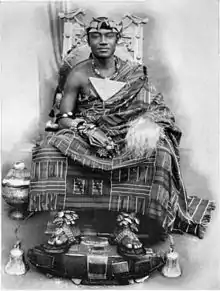
West African cultures have been weaving textiles for thousands of years. [4] Kente may have developed from a variety of weaving traditions which existed in Ghana since before the 11th century, with excavations in the region showing instruments such as spindles, whorls, and loom weights. [5] By the 17th century, during the rise of the Ashanti Empire, Kente became popularized among Akan royalty, and by the early 19th century master weavers and Kente houses could be seen throughout the Ashanti capital of Kumasi.
Production
Kente production can be classified by three versions: authentic Kente cloth made by traditional weavers, Kente print produced by brands such as Vlisco and Akosombo Textile LTD, and mass-produced Kente pattern typically produced in China for Westerners. Authentic Kente cloth is the most expensive, while Kente print varies in price depending on production style.
For authentic Kente, the towns of Bonwire, Sakora Wonoo, Ntonso, Safo and Adanwomase are noted for Kente weaving, and are located in the Ashanti region.
Weaving is done on a wooden loom in which multiple threads of dyed fabric are pressed together. Weavers are typically apprentice under a master weaver or company for a number of years before producing their own patterns. Rolls of cloth are then imprinted with a brand to signify authenticity. [6]
Characteristics
Kente patterns varies in complexity, with each pattern having a name or message by the weaver. Ghanaians choose kente cloths as much for their names as their colors and patterns. Although the cloths are identified primarily by the patterns found in the lengthwise (warp) threads, there is often little correlation between appearance and name. Names are derived from several sources, including proverbs, historical events, important chiefs, queen mothers, and plants. The cloth symbolizes high in value.
Ahwepan refers to a simple design of warp stripes, created using plain weave and a single pair of heddles. The designs and motifs in kente cloth are traditionally abstract, but some weavers also include words, numbers and symbols in their work.[2] Example messages include adweneasa, which translates as "i've exhausted my skills", is a highly decorated type of kente with weft-based patterns woven into every available block of plain weave. Because of the intricate patterns, adweneasa cloth requires three heddles to weave.[7][8]
Symbolic meanings of the colors
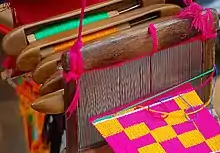
- black: maturation, intensified spiritual energy, spirits of ancestors, passing rites, mourning, and funerals
- blue: peacefulness, harmony, and love
- green: vegetation, planting, harvesting, growth, spiritual renewal
- gold: royalty, wealth, high status, glory, spiritual purity
- grey: healing and cleansing rituals; associated with ash
- maroon: the color of mother earth; associated with healing
- pink: assoc. with the female essence of life; a mild, gentle aspect of red
- purple: assoc. with feminine aspects of life; usually worn by women
- red: political and spiritual moods; bloodshed; sacrificial rites and death.
- silver: serenity, purity, joy; associated with the moon
- white: purification, sanctification rites and festive occasions
- yellow: preciousness, royalty, wealth, fertility, beauty
Controversy
In June 2020, Democratic Party leaders in the United States caused controversy by wearing stoles made of kente cloth to show support against systemic racism.[10] While it was claimed to be an act of unity with African-Americans, many, including Jade Bentil, a Ghanaian-Nigerian researcher, voiced objection tweeting "My ancestors did not invent Kente cloth for them to be worn by publicity (obsessed) politicians as 'activism' in 2020". On the other hand Congressional Black Caucus chair Karen Bass said, at a news conference for the introduction of the Justice in Policing Act of 2020, that the white lawmakers were showing solidarity, and April Reign, who is credited with initiating the #OscarsSoWhite hashtag,[11] while not a fan of the symbolism, suggested that the legislation's fate is more relevant than the event in the Capitol's Emancipation Hall.
References
- Anquandah, James; Kankpeyeng, Benjamin (2014). Current Perspectives in the Archaeology of Ghana. African Books Collective. ISBN 978-9988-8602-6-4.
- Boateng, Boatema (2011). The copyright thing doesn't work here: Adinkra and Kente cloth and intellectual property in Ghana. Minneapolis: University of Minnesota Press. ISBN 978-0-8166-7679-8. OCLC 741751637.
- Konadu, Kwasi (2007). Indigenous medicine and knowledge in African society. Routledge. p. 30–31. ISBN 9780203941393.
- Colleen E. Kriger (2006). Cloth in West African History. Rowman Altamira. pp. 22–23. ISBN 978-0-7591-0422-8.
- Editor (26 March 2016). "Bonwire Kente Weaving Village". touringghana.com. Retrieved 11 August 2020.CS1 maint: extra text: authors list (link)
- Smith, Shea Clark (1975). "Kente Cloth Motifs". African Arts. 9 (1): 36–39. doi:10.2307/3334979. ISSN 0001-9933. JSTOR 3334979.
- Gilfoy, Peggy (1987). Patterns of life: West African strip-weaving traditions. Published for the National Museum of African Art by the Smithsonian Institution Press. p. 47. ISBN 9780874744750.
- "Wrapper (kente, oyokoman adwireasu)". Smithsonian National Museum of African Art. Retrieved 16 December 2018.
- Kente Cloth Archived 2009-01-06 at the Wayback Machine. "African Journey". projectexploration.org. 25 September 2007.
- Lee, Alicia (8 June 2020). "Congressional Democrats criticized for wearing Kente cloth at event honoring George Floyd". CNN. Retrieved 12 June 2020.
- Griggs, Brandon (14 January 2016). "Once again, #OscarsSoWhite". CNN. Retrieved 12 June 2020.
External links
| Wikimedia Commons has media related to Kente. |
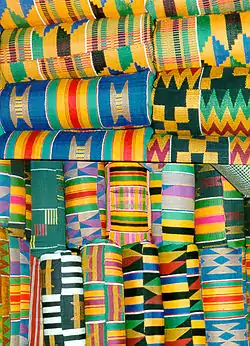
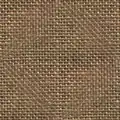
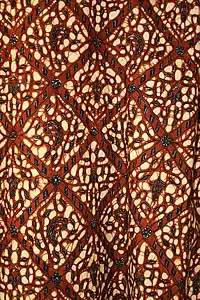
.svg.png.webp)